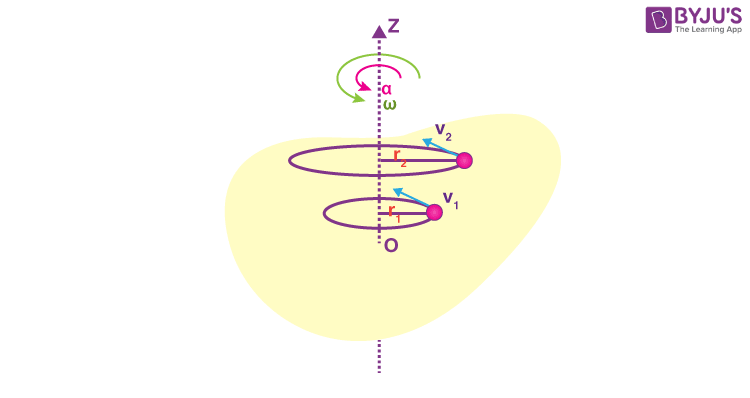Download presentation
Presentation is loading. Please wait.
Published byCaitlin Haynes Modified over 8 years ago
1 Rotational Kinematics HRK Chapter 8 http://ia700709.us.archive.org/4/items/AP_Physics_C _Lesson_17/Container.html http://ia600204.us.archive.org/17/items/AP_Physics_C _Lesson_15/Container.html http://www.learnapphysics.com/apphysi csc/rotational_motion.php
2 Table Of Contents 1.Rotational Motion and Angular Displacement 2.Angular Velocity and Angular Acceleration 3.The Equations of Rotational Kinematics 4.Angular Variables and Tangential Acceleration 5.Centripetal Acceleration and Tangential Acceleration 6.Rolling Motion 7.The Vector Nature of Angular Variables
3 Five kinematic variables Making Sense of it All displacement initial velocity final velocity elapsed time acceleration d or x V o (m/s) V (m/s) t (sec) a (m/s 2 ) (radians) o r(radians /sec) (radians /s 2 ) Lesson 3 : t (sec) (radians /sec)
4 Five kinematic variables Making Sense of it All displacement initial velocity final velocity elapsed time acceleration d or x = r V o (m/s) V (m/s) = r t (sec) a (m/s 2 ) = r (radians) o r(radians /sec) (radians /s 2 ) VARIABLES : t (sec) (radians /sec)
5 The “Equations” Rotational kinematics with constant angular acceleration: Linear Kinematics with constant Linear acceleration: Formulas
6 The “Equations” MORE EQUATIONS : Rotational kinematics with constant angular acceleration: Linear Kinematics with constant Linear acceleration:
7 Lesson 1: Rotational Kinematics Section 1: Rotational Motion and Angular Displacement Homework : READ HRK page: 159 – 167 Page 168 #’s 1 – 8 Chapter 8EXAMPLES Do Now Do Now : HRK Page: 160 Example 1
8 First there was displacement (d) Need to develop new variables for polar system The angle through which the object rotates is called the Angular displacement. LESSON 1
9 DEFINITION OF ANGULAR DISPLACEMENT When a rigid body rotates about a fixed axis, the angular displacement is the angle swept out by a line passing through any point on the body and intersecting the axis of rotation perpendicularly. By convention, the angular displacement is positive if it is counterclockwise and negative if it is clockwise. SI Unit of Angular Displacement: radian (rad) LESSON 1
10 For a full revolution:
11 Lesson 2 Rotational Kinematics Section 2: Angular Velocity and Angular Acceleration Homework : HRK page: #’s Do Now Do Now : HRK
12 How do we describe the rate at which the angular displacement is changing? Next, there was “velocity” Lesson 2 Radians
13 DEFINITION OF AVERAGE ANGULAR VELOCITY SI Unit of Angular Velocity: radian per second (rad/s) Lesson 2
14 Example 3 Gymnast on a High Bar A gymnast on a high bar swings through two revolutions in a time of 1.90 s. Find the average angular velocity of the gymnast. Lesson 2
15 INSTANTANEOUS ANGULAR VELOCITY IInstantaneous Angular speed TThe magnitude of the instantaneous angular velocity SI Unit of Instantaneous Angular velocity: radian per second (rad/s) Lesson 2
16 Changing angular velocity means that an angular acceleration is occurring. DEFINITION OF AVERAGE ANGULAR ACCELERATION SI Unit of Angular acceleration: radian per second per second (rad/s 2 ) Then, there was “acceleration”
17 Lesson 3: Rotational Kinematics Section 3: The Equations of Rotational Kinematics Homework :
18 The “Equations” Lesson 3 : Rotational kinematics with constant angular acceleration: Linear Kinematics with constant Linear acceleration: More Coming!!!!
19 Reasoning Strategy 1. Make a drawing. 2. Decide which directions are to be called positive (+) and negative (-). (Counterclockwise default +) 3. Write down the values that are given for any of the five kinematic variables. 4. Verify that the information contains values for at least three of the five kinematic variables. Select the appropriate equation. 5. When the motion is divided into segments, remember that the final angular velocity of one segment is the initial velocity for the next. 6. Keep in mind that there may be two possible answers to a kinematics problem. Lesson 3 :
20 Example 5 Blending with a Blender The blades are whirling with an angular velocity of +375 rad/s when the “puree” button is pushed in. When the “blend” button is pushed, the blades accelerate and reach a greater angular velocity after the blades have rotated through an angular displacement of +44.0 rad. The angular acceleration has a constant value of +1740 rad/s 2. Find the final angular velocity of the blades. Lesson 3 :
21 θθ αωωoωo t +44.0 rad+1740 rad/s 2 ?+375 rad/s Lesson 3 :
22 PROBLEM 9 The Earth, which has an equatorial radius of 6380 km, makes one revolution on its axis every 23.93 hours. What is the tangential speed of Nairobi, Kenya, a city near the equator? a) 37.0 m/s b) 74.0 m/s c) 148 m/s d) 232 m/s e) 465 m/s Lesson 3 :
23 PROBLEM 10 The original Ferris (an RPI Graduate) wheel had a radius of 38 m and completed a full revolution (2 radians) every two minutes when operating at its maximum speed. If the wheel were uniformly slowed from its maximum speed to a stop in 35 seconds, what would be the magnitude of the instantaneous tangential speed at the outer rim of the wheel 15 seconds after it begins its deceleration? a) 0.295 m/s b) 1.12 m/s c) 1.50 m/s d) 1.77 m/s e) 2.03 m/s Lesson 3 :
24 PROBLEM 11 A long, thin rod of length 4L rotates counterclockwise with constant angular acceleration around an axis that is perpendicular to the rod and passes through a pivot point that is a length L from one end as shown. What is the ratio of the tangential acceleration at a point on the end closest to the pivot point to that at a point on the end farthest from the pivot point? a) 4 b) 3 c) 1/2 d) 1/3 e) 1/4 Lesson 3 :
25 PROBLEM 12 A long, thin rod of length 4L rotates counterclockwise with constant angular acceleration around an axis that is perpendicular to the rod and passes through a pivot point that is a length L from one end as shown. What is the ratio of the tangential speed (at any instant) at a point on the end closest to the pivot point to that at a point on the end farthest from the pivot point? a) 1/4 b) 1/3 c) 1/2 d) 3 e) 4 Lesson 3 :
26 Tangential Acceleration? We define the axes as polar co-ordinates not Cartesian. (r, ) not (x,y) Since they are perpendicular, we can treat each axis independently Therefore, total acceleration would be vector sum of a c plus a T Lesson 3
27 PROBLEM 14 A Discus Thrower Starting from rest, the thrower accelerates the discus to a final angular speed of +15.0 rad/s in a time of 0.270 s before releasing it. During the acceleration, the discus moves in a circular arc of radius 0.810 m. Find the total acceleration. Lesson 3
29 3.7 An airplane starts from rest at the end of a runway and begins accelerating. The tires of the plane are rotating with an angular velocity that is uniformly increasing with time. On one of the tires, Point A is located on the part of the tire in contact with the runway surface and point B is located halfway between Point A and the axis of rotation. Which one of the following statements is true concerning this situation? a) Both points have the same tangential acceleration. b) Both points have the same centripetal acceleration. c) Both points have the same instantaneous angular velocity. d) The angular velocity at point A is greater than that of point B. e) Each second, point A turns through a greater angle than point B. Lesson 3
30 3.8 A wheel starts from rest and rotates with a constant angular acceleration. What is the ratio of the instantaneous tangential acceleration at point A located a distance 2r to that at point B located at r, where the radius of the wheel is R = 2r? a) 0.25 b) 0.50 c) 1.0 d) 2.0 e) 4.0 Lesson 3
31 Lesson 4: Rotational Kinematics Section 6: Rolling Motion Homework : HRK Page #’s
32 Rolling Motion A rolling object is a common example of when you would need to be able to transform from one coordinate system to the other. Usually a “rolling” object will not be slipping on the surface. Lesson 4
33 The tangential speed of a point on the outer edge of the tire is equal to the speed of the car over the ground. Lesson 4
34 Example 4.1 An Accelerating Car Starting from rest, the car accelerates for 20.0 s with a constant linear acceleration of 0.800 m/s 2. The radius of the tires is 0.330 m. What is the angle through which each wheel has rotated? Lesson 4
35 θαωωoωo t ?-2.42 rad/s 2 0 rad/s20.0 s Lesson 4
36 4.1 The wheels of a bicycle have a radius of r meters. The bicycle is traveling along a level road at a constant speed v m/s. Which one of the following expressions may be used to determine the angular speed, in rev/min, of the wheels? a) b) c) d) e) Lesson 4
37 4.2. Josh is painting yellow stripes on a road using a paint roller. To roll the paint roller along the road, Josh applies a force of 15 N at an angle of 45 with respect to the road. The mass of the roller is 2.5 kg; and its radius is 4.0 cm. Ignoring the mass of the handle of the roller, what is the magnitude of the tangential acceleration of the roller? a) 4.2 m/s 2 b) 6.0 m/s 2 c) 15 m/s 2 d) 110 m/s 2 e) 150 m/s 2 Lesson 6
38 4.3. Which one of the following statements concerning a wheel undergoing rolling motion is true? a) The angular acceleration of the wheel must be zero m/s 2. b) The tangential velocity is the same for all points on the wheel. c) The linear velocity for all points on the rim of the wheel is non-zero. d) The tangential velocity is the same for all points on the rim of the wheel. e) There is no slipping at the point where the wheel touches the surface on which it is rolling. Lesson 4
39 4.4. A circular hoop rolls without slipping on a flat horizontal surface. Which one of the following is necessarily true? a) All points on the rim of the hoop have the same speed. b) All points on the rim of the hoop have the same velocity. c) Every point on the rim of the wheel has a different velocity. d) All points on the rim of the hoop have acceleration vectors that are tangent to the hoop. e) All points on the rim of the hoop have acceleration vectors that point toward the center of the hoop. Lesson 4
40 4.5. A bicycle wheel of radius 0.70 m is turning at an angular speed of 6.3 rad/s as it rolls on a horizontal surface without slipping. What is the linear speed of the wheel? a) 1.4 m/s b) 28 m/s c) 0.11 m/s d) 4.4 m/s e) 9.1 m/s Lesson 4
41 Lesson 5: Rotational Kinematics Section 7: The Vector Nature of Angular Variables
42 Real World Meets the Right Hand TThe direction of the angular velocity vector point along the axis of rotation. RRight-Hand Rule: G rasp the axis of rotation with your right hand, so that your fingers circle wrap the axis in the same direction as the rotation. YYour extended thumb points along the axis in the direction of the angular velocity. Lesson 5
43 5.1. A packaged roll of paper towels falls from a shelf in a grocery store and rolls due south without slipping. What is the direction of the paper towels’ angular velocity? a) north b) east c) south d) west e) down Lesson 7
44 5.2. A packaged roll of paper towels falls from a shelf in a grocery store and rolls due south without slipping. As its linear speed slows, what are the directions of the paper towels’ angular velocity and angular acceleration? a) east, east b) west, east c) south, north d) east, west e) west, west Lesson 7
45 5.3. A top is spinning counterclockwise and moving toward the right with a linear velocity as shown in the drawing. If the angular speed is decreasing as time passes, what is the direction of the angular velocity of the top? a) upward b) downward c) left d) right Lesson 5
46 5.4. A truck and trailer have 18 wheels. If the direction of the angular velocity vectors of the 18 wheels point 30 north of east, in what direction is the truck traveling? a) 30° east of south b) 30° west of north c) 30° north of east d) 30° south of west e) 30° south of east Lesson 5
47 5.5. A girl is sitting on the edge of a merry-go-round at a playground as shown. Looking down from above, the merry-go-round is rotating clockwise. What is the direction of the girl’s angular velocity? a) upward b) downward c) left d) right e) There is no direction since it is the merry go round that has the angular velocity. Lesson 5
48 PROBLEM 1 Adjacent Synchronous Satellites Synchronous satellites are put into an orbit whose radius is 4.23×10 7 m. If the angular separation of the two satellites is 2.00 degrees, find the arc length that separates them. LESSON 1
49 PROBLEM 2 Over the course of a day (twenty-four hours), what is the angular displacement of the second hand of a wrist watch in radians? a) 1440 rad b) 2880 rad c) 4520 rad d) 9050 rad e) 543 000 rad c) 60 min/hr * 24 hr = 1440 revolutions * 2π = 9047 rad LESSON 1
50 PROBLEM 3 A Jet Revving Its Engines As seen from the front of the engine, the fan blades are rotating with an angular speed of -110 rad/s. As the plane takes off, the angular velocity of the blades reaches -330 rad/s in a time of 14 s. Find the angular acceleration, assuming it to be constant. Lesson 2
51 PROBLEM 4 : The planet Mercury takes only 88 Earth days to orbit the Sun. The orbit is nearly circular, so for this exercise, assume that it is. What is the angular velocity, in radians per second, of Mercury in its orbit around the Sun? a) 8.3 × 10 7 rad/s b) 2.0 × 10 5 rad/s c) 7.3 × 10 4 rad/s d) 7.1 × 10 2 rad/s e) This cannot be determined without knowing the radius of the orbit. Lesson 2 88 days/Rev * 24 hr/day* 3600 sec/ hr = 7.6032 X 10 6 sec/revolution 2π rad / revolution = 8.2639 × 10 7 rad/s
52 PROBLEM 5 Complete the following statement: For a wheel that turns with constant angular velocity, a) each point on its rim moves with constant acceleration. b) the wheel turns through “equal angles in equal times.” c) each point on the rim moves at a constant linear speed. d) the angular displacement of a point on the rim is constant. e) all points on the wheel are moving at a constant angular velocity. Lesson 2 All True!
53 PROBLEM 6 The propeller of an airplane is at rest when the pilot starts the engine; and its angular acceleration is a constant value. Two seconds later, the propeller is rotating at 10 rad/s. Through how many revolutions has the propeller rotated through during the first two seconds? a) 300 b) 50 c) 20 d) 10 e) 5 Lesson 3 :
54 Problem 7 A ball is spinning about an axis that passes through its center with a constant angular acceleration of rad/s 2. During a time interval from t 1 to t 2, the angular displacement of the ball is radians. At time t 2, the angular velocity of the ball is 2 rad/s. What is the ball’s angular velocity at time t 1 ? θ= α= rad/s 2 ω 2 = 2 rad/s ω 1 = ?? t= a) 6.28 rad/s b) 3.14 rad/s c) 2.22 rad/s d) 1.00 rad/s e) zero rad/s Lesson 3 : e) Zero rad/sec
55 PROBLEM 8 A Helicopter Blade A helicopter blade has an angular speed of 6.50 rev/s and an angular acceleration of 1.30 rev/s 2. For point 1 on the blade, find the magnitude of (a) the tangential speed and (b) the tangential acceleration. Lesson 3 :
Similar presentations
© 2024 SlidePlayer.com Inc.
All rights reserved.




